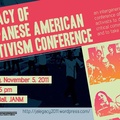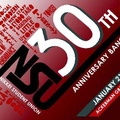After 20 years as director of the University of California, Los Angeles’ Asian American Studies Center (AASC), Professor Don Nakanishi retired from his tenure in July 2009. A dedicated and visionary leader, Professor Nakanishi has made instrumental changes in making the AASC flourish into the nation’s premier research center in its field.

Don Nakanishi in his office at the Asian American Studies Center at the University of California, Los Angeles.
Advancing the Asian American Studies (AAS) field in breadth and depth, Don Nakanishi has proven himself as a distinguished scholar, teacher and activist for Asian Americans. Receiving his B.A. in Intense Political Science at Yale in 1971 and completing his Ph.D. in Political Science at Harvard in 1978, Don is a world-renowned authoritative figure on Asian American politics. He co-founded the Amerasia Journal in 1970, the top academic journal in its field; he compiled lists of Asian American elected officials in the United States, which culminated into the National Asian Pacific American Political Almanac, whose subsequent editions serve as integral guides on Asian American politics. He successfully increased the number of AAS faculty to 40 specialists in Asian American Studies; and he has trained hundreds of graduate students at UCLA.
Not only has he been active in the academic field, but Don has also played crucial roles within the community, which include his contributions as a member of the Board of Governors for the Japanese American National Museum. He serves as an indelible leader in forging bridges among the Asian American Studies (AAS) communities—helping to organize the first UC (University of California) system-wide consortium on Asian American Studies and Public Policy, which ties AAS professors to leaders of community based organizations, along with Asian/Pacific Islander politicians across California.
From where did this dedication and passion for Asian American politics and education arise? Brought up in Boyle Heights by Nisei-Kibei parents (Americans of Japanese descent who are raised in Japan and return to America), Don lived a life steeped in Japanese traditions. He was “very involved in the Japanese American community…[he] went to the Nishi Honganji Buddhist temple, played JA sports that were not just basketball but also baseball, swimming and track…and went to Japanese school up until the 11th grade.” However, the majority of Nisei and Sansei spoke English at home, so even in the large Japanese American community in West Los Angeles “there was only one other guy who went to Japanese school in [his high school] class.” Though his parents hoped Don would retain a strong tie to Japan as a Nikkei through the language and home traditions, he attributes the missing piece of such a connection to his limited visits to Japan. Without frequent exposure and constant interaction with the rest of his relatives, Don could never truly be “Japanese.”
Yet language did not fully exemplify the differences between the Nisei-Kibei and the other Nisei in the home environment they provided for their children. The growing differences among the Sansei children, like Don, became more apparent with the changes in their social classes. Don’s parents were shy individuals comfortable with those who were fluent or bilingual in Japanese. Limited in their English skills, his father worked as a produce manager and his mother worked as a seamstress downtown. Many of the other Nisei predominantly spoke English and became doctors and optometrists, eventually moved out of Boyle Heights into areas such as Monterey Park and Montebello. Furthermore, because Boyle Heights was home to a strong Mexican American community, Don lived in “two parallel, even meshed worlds with a lot of racial diversity.” His local high school, Roosevelt, was predominantly Mexican American, so he was immersed in, and felt very comfortable with, this environment. Thus, he did not have a purely Japanese or Japanese American experience.
Growing up within these two cultures gave Don an enriched childhood, and even at a young age Don was a brilliant student and a promising leader. By high school graduation he was named Boy Mayor of the City of Los Angeles. Even so, Don firmly believes the Watts Riot of 1965 heavily influenced his acceptance to Yale. This violent incident in the South Central area of Los Angeles became one of the greatest examples of racial tension America has ever seen. “Without the Watts Riots Yale would never have come to a school like Roosevelt.” A prestigious school such as Yale coming to recruit students from an underprivileged high school like Roosevelt in Boyle Heights was unheard of, and was only possible due to concerns about discrimination and social tension exacerbated by social disorders such as the Watts Riot. Thus, Don became a part of Yale’s first “Most Diverse Class” out of 1000 men there were 7 African Americans, 7 Latinos, and 7 Asian Americans.
It was at this elite university that Don experienced an event that would lead to a shift in his career choice and eventually take him down the path to actively be involved in Asian American Studies. Like many other Asian children, Don began his studies in biology, as his parents wanted him “to be a doctor…or at least serve the Japanese American community and put his Japanese skills to use.” But this began to change during his first year as a college student. Don recalls how “Every year on December 7th, a teacher—it didn’t matter what subject—would ask ‘Do you know what happened on this day?’ and everyone would look at the JA kids when they told us ‘Japan bombed Pearl Harbor today.’ Even 20-something years after the war ended we were still being reminded.” Although they personally had nothing to do with the act, the Nikkei felt a sense of guilt wash over them. But on December 7th of his freshman year in college, Don went through his classes without incident. “You know…it’s Yale. You wouldn’t expect things like that.”
Or so he thought. That night all the men on Don’s floor trooped into his dorm room and pelted him with water balloons chanting “Bomb Pearl Harbor! Bomb Pearl Harbor!” A national high school debate champion came up to him to recite, from memory, Franklin Delano Roosevelt’s declaration of war speech. Amidst this entire fiasco Don stood, dripping in his wet clothes, going through mixed emotions. “I didn’t know whether to laugh or cry, or whatever.” It is this incident that drove him to open his first book on the Japanese American concentration camps—Prejudice, War, and the Constitution by Tenbrook, Barnhardt, and Mason. “My parents never talked about it [being incarcerated]…you know, they were No-No’s.” His background as a Nikkei would become one of the factors that would lead to his entrance into the Asian American field.
With this knowledge of the injustices of the mass incarceration of Japanese Americans during World War II, this interest soon cultivated into a full-blown, student-driven initiative for raising Asian American awareness. A young Glenn Omatsu (an avid activist of the 1960s and a well-known educator on Asian American Studies) inquired “How about the Asian American students? Are they organized?” and this became the catalyst for forging the way for Yale’s Asian American students. Don built on the foundations that he developed in helping to found M.E.Ch.A (Chicano Student Movement of Aztlan), a grassroots student association for Mexican Americans, to initiate an Asian American movement on campus. This soon led to a whirlwind of events that led to greater investments in actively engaging the Asian Americans on campus in their roles in politics and education. What started as an interest in his own heritage would eventually become a lifelong endeavor to shed light on the political participation and educational status of Asian Americans.
Although Don has expanded beyond the Japanese American experience, as a scholar who has traced the changes among, and made contributions to Asian Americans in politics and public policy, it begs the question of tracing back to his roots: how does Don perceive the way Japanese Americans have changed? He notes that the most apparent changes are in the demographics: there are relatively fewer Japantowns, and Japanese Americans now rank 6th amongst the Asian American population in the United States in comparison to being the largest group in the mid-1900s. But when posed with the question of how he would define Nikkei, Don frankly answered, “I don’t know…There is more diversity than the set standard that tended to look at generations monolithically. Issei, Nisei, and Sansei—they were supposed to reveal a lot. It’s more of a label to which we associate certain attributes.” Among the earlier generations Issei, Nisei, and Sansei used to be conceptualized as “insight about certain attributes correlating with their generation, and yet many of those can be obsolete today.” Though Don is a Sansei whose parents are Nisei-Kibei, he no longer speaks Japanese the way he did as a child. On the other hand, his Yonsei son Thomas annually visits Japan and attended Japanese school, where he and his J-school friends have grown together and still keep in touch; the same cannot be said of the earlier generations of Japanese Americans. This trend among the younger generations is stimulating a rekindled interest in their Japanese roots and heritage, which further refutes the misconception that our Japantowns and the Nikkei culture are dying. Although there now remain three of the original Japanese enclaves (San Jose, San Francisco, and Little Tokyo), “there are lots of thriving centers of Japanese culture such as Torrance and Sawtelle.” As his field of work revolves around Asian Americans in politics, such stereotypes and widely held beliefs obscure our vision in understanding just how diverse Asian Americans actually are and how this impacts their representation in the political realm.
Though he has retired from his tenure as director of Asian American Studies Center at UCLA, Don will continue his research on Asian American politics and education, delving into how Asian Americans internationally are mobilizing in US-Asia relations on both domestic and political levels. In addition, he will have a focus on Australia to research the significant Asian Australian community that has established there as well as wherein lie the patterns of influence of these Asian Australian voting blocs.
© 2009 Yoshimi Kawashima





